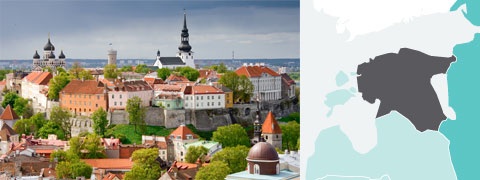Country assessments
Estonia
- Details
- Country assessments
2013 sector transition indicators
Source: EBRD.
Note: Water – Water and wastewater; IAOFS – Insurance and other financial services; PE – Private equity.
Highlights
- Economic growth slowed considerably in 2012, and further in the first half of 2013. Estonia was among the fastest growing economies in the European Union (EU) last year, but weak external demand started weighing on growth.
- The fiscal accounts are among the strongest in the EU. The fiscal deficit remained small and public debt is the lowest in the EU, providing a comfortable buffer against economic and revenue volatility.
- Conditions in the labour market improved further as unemployment dropped to 8 per cent in June. The government seeks to address skills mismatches and issues confronting low wage earners.
Key priorities for 2014
- As foreign bank deleveraging continues, the development of domestic sources of funding, including from domestic pension funds, should be advanced.
- Continuous upgrading of workforce skills remains essential. This is particularly important given the rapidly changing technology sector, and shifts in the position of important foreign direct investors located in Estonia. Closer cooperation with private sector employees may increase the efficiency of the government’s existing programmes.
- High energy prices remain a constraint on growth. Deregulation of electricity supplies could be followed by similar steps in the electricity transmission network.
Macroeconomic performance
Economic growth moderated in 2012 and slowed further in the first half of 2013. After a strong expansion of GDP in 2011, of 9.6 per cent, growth slowed significantly last year, but, at 3.9 per cent, it remained among the highest rates of growth in the EU. This underlines that the strong post-crisis recovery is coming to an end. Over the first half of this year output growth of 1.2 per cent was primarily driven by private consumption, as growth in export volumes slowed and investment contracted.
The two years immediately following the 2008-09 financial crisis saw a particularly strong recovery in export volumes of approximately 23 per cent per annum, on average. This export growth was underpinned by much-improved competitiveness indicators, which was evident in a fall of 12.4 per cent in real unit labour costs. However, annual export growth dropped to 5.6 per cent in 2012, on the back of weaker demand from Russia, Sweden and Finland, which together represent approximately 42 per cent of Estonia’s export market. Trade data for the first half of 2013 show a further slow-down in the rate of exports growth, although exports are still supportive of growth.
The contraction in investment has been a further drag on growth. Following 23.4 per cent average annual growth in 2011 and 2012, gross fixed capital formation volume declined by 3.7 per cent over the first half of 2013. Since much of the slow-down can be attributable to the end of government-subsidised construction funding, this contraction underlines a lack of private sector investment demand. With the current government strongly committed to very conservative budget targets, low public investment volumes are likely to remain a hindrance on GDP growth. After a lengthy period of deleveraging, early signs of a pick-up in bank lending over the first half of this year may, over time, support investment.
Fiscal performance remains very strong. Estonia is the only country in the central Europe and the Baltic states (CEB) region that was able to afford to loosen fiscal policies last year. The government registered a surplus in 2010 and 2011, and public capital expenditures were stepped up to support economic activity, resulting in a small overall deficit of 0.2 per cent of GDP last year. The budget deficit is expected to narrow in 2013, and to return again to surplus in 2014. According to the European Commission’s 2013 spring forecasts, Estonia’s public debt is expected to peak at 10.2 per cent of GDP this year, remaining the lowest in the EU by a large margin.
Major structural reform developments
Estonia exhibits the most advanced structural reform indicators in the transition region. Of 16 sectors assessed through the EBRD’s transition indicators, only three sectors showed a medium gap for market structure, and five sectors showed a medium gap for market institutions. Although the economy dropped one position, to twenty-second place, in the World Bank 2014 Doing Business report, Estonia remains among the highest rated countries in the transition region, scoring particularly strongly on trading across borders and registering property. The latest update in the competitiveness indicators of the World Economic Forum similarly continues to rank the country relatively highly, at ninth place in the EU, and the highest of all new EU member states.
Continuous upgrading of skills and vocational training nevertheless remain key priorities for the government. As unemployment declines, the growing number of vacancies points to a significant skills mismatch in the labour market. This can be partially explained by outward migration, although most emigrants were not skilled in the areas of the greatest demand. To address this issue, the government has refocused vocational training on skills required by employers, has introduced flexibility in voucher training programmes, and plans to allow for a wider variety of professional certifications.
The government increased the minimum wage. The 10 per cent increase in the minimum wage, effective from January 2013, raises the minimum monthly salary to €320, and is intended to reduce social and income inequalities following several years of austerity. Higher salaries among low-income earners are a strong driver of average wages, which grew by 8.5 per cent in annual terms over the second quarter of 2013. However, as minimum wage growth has outpaced labour productivity growth, the impact on low-skilled workers needs to be carefully monitored. As yet, no loss of competitiveness or impact on employment has been apparent. Unemployment continues to fall, and is now at 8 per cent, after peaking at nearly 20 per cent in 2010.
Estonia ranks fourteenth in the Innovation Union Scoreboard. Unlike most of the EBRD’s countries of operations, Estonia ranks near to the EU average, and was classified in the second-highest group of EU countries, in terms of innovation activity. The economy is an EU leader in terms of increasing innovation performance, and has rapidly decreased the gap between it and the most innovative members. The government’s efforts remain focused on strengthening the commercial application of research, through enhancing cooperation among relevant institutions, most notably between universities, technical schools and private sector entities.
The country has retained its position as the most technologically advanced exporter of the three Baltic countries. During the strong export growth period, between 2010 and 2012, the proportion of high technology exports has further increased. For example, the export value of machinery and transport equipment reached 25 per cent of GDP in 2012, compared to 12 and 10 per cent, in Lithuania and Latvia respectively.
High domestic energy prices remain a constraint on growth, although the domestic electricity market was deregulated. As of January 2013, the authorities approved a deregulation package, which increased the number of suppliers in the domestic electricity market. Consumers are now able to purchase electricity from seven alternative providers, but the state-owned incumbent (Eesti Energia) retains an entrenched position as the dominant supplier in the market. The introduction of a deregulation law resulted in significant price increases in the beginning of this year, with transmission costs representing approximately 36 per cent of household bills, on average. It is likely that these price increases are the result of the lack of competition in the transmission network, which remains under monopoly control by the state-owned transmission system operator, Elering. However, prices are expected to fall next year, as new international electricity links (such as Est-Link 2) become operational.













